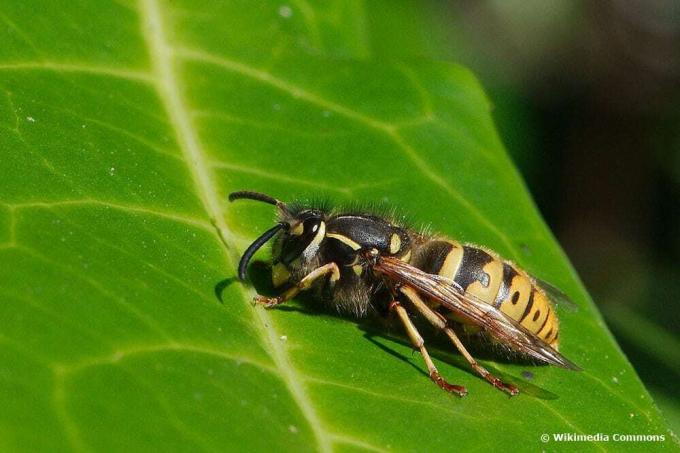
table of contents
- hornet
- Wasp queen
- Nests
- time
- frequently asked Questions
Is it a hornet or a wasp queen? We show you which clear characteristics you can use to recognize the difference comparatively easily.
In a nutshell
- both species must not be killed
- easy to distinguish by the color
- Hornets are bigger
- Wasps and hornets are beneficial insects in the garden
- Wasps become aggressive more quickly
hornet
Hornets are often more feared than wasps, but they are usually much more peaceful. This is due to their size and overall appearance, which also earned them the name "giant wasp". However, it is not always easy to determine the difference to wasps, since the workers of the hornets are similar in size.
Unique features include:
- small colony of only up to 700 animals
- rear part of the body conspicuously yellow
- Length from 18 to 35 millimeters
- reddish-brown head and trunk
- very low hum
- The front and back are separated by a slight waist
However, the best differentiators are still size and coloration. A wasp queen is still difficult to differentiate due to her size.

Note: They feed predatory and can therefore only be found on flowers and plants when other insects also gather there.
Wasp queen
Wasp queens can be confused with hornets mainly because they are comparatively large. In terms of body length, they roughly correspond to a worker hornet.
Clear features are also:
- Working wasps 11 to 14 millimeters long
- clearly recognizable wasp waist
- no hair
- Body length of the wasp queen up to 20 millimeters
- black stripes from the head
- State size from 3,000 to 4,000 animals

In the case of the wasp queens, the torso is visually much more separated from the abdomen and they have a more even stripe pattern. However, this can usually only be recognized if the insects have been at rest long enough.
Another indication can be that the wasps are more often found on flowers or at the dining table outdoors. They mainly feed on vegetable sources such as:
- Tree saps
- nectar
- Pollen
When they take care of the offspring, on the other hand, they switch to high-protein and high-sugar feed. Therefore, jams and cakes can be just as attractive to them as ham, for example.
Nests
The wasp queen and the hornets fly out of their winter quarters between the end of April and the beginning of June, depending on the temperatures, and begin to build a nest for the entire colony. To do this, they use wood, among other things, which they scrape off tree bark, trees, rotten wood or building material. Paper and cardboard are also used.
The wood fibers are stuck together with saliva and the nest is strengthened and expanded until the queen has laid the first eggs. This task is then taken over by the hatched workers. The full size is therefore only reached in August or even in September.
Wasp nest:
- round shape
- The size of a medicine ball
- in the ground or other dark, sheltered places
- Often difficult to find nests

Hornet's Nest:
- elongated shape
- up to 60 cm
- Trees as a base
- also roof trusses or on house walls

time
Due to nest building and reproduction, the hornet queen and the wasp queen are only active between April and June. After that, their main task is to lay eggs. From this point on, the workers take care of the nest and care. If you see a supposed wasp queen in July or August, it is very likely a hornet.
frequently asked Questions
No, just like a hornet's nest, it cannot simply be removed. However, there are exceptions if there is a danger. This can be the case, for example, if the nest is in the house or in highly frequented areas. Expert help should be sought for relocating or removing.
No, as long as you are not threatened directly, the animals are extremely peaceful. For this reason, among other things, they are spotted less often than wasps.
Hornets in particular feed to a large extent on harmful insects. They therefore help protect plants and maintain a natural balance.
Only one young queen goes into hibernation. The rest of the state only lives for a year or season and dies in the fall. Wintering does not take place in the nest. The animals look for other quarters.
No, because they can have a deterrent effect and are usually only inhabited once. So it is neither necessary nor beneficial to remove them.



